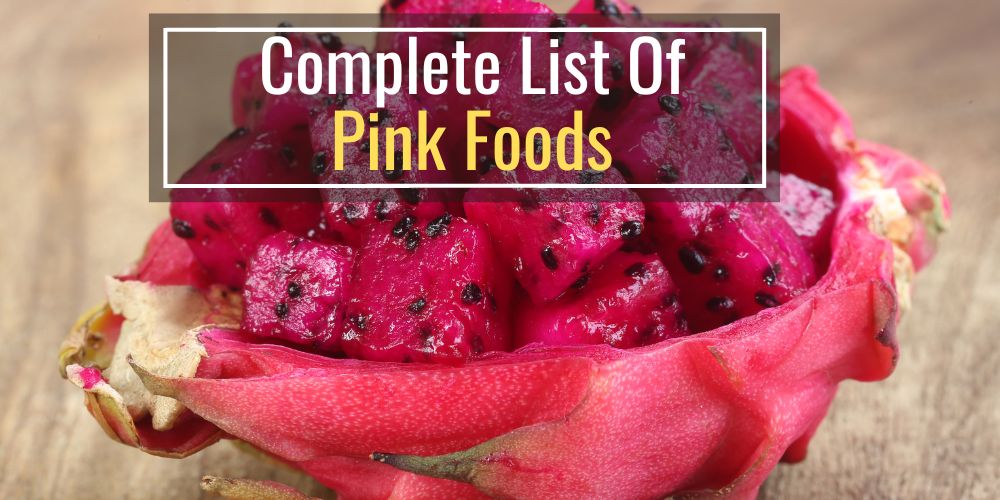There are several foods that are pink, and many people might not realize just how many there are.
This list will highlight some of the most popular and well-known pink foods, as well as some lesser-known items.
From pigmented fruit to fun desserts, there’s something for everyone on this list.
So, if you’re longing for a way to add a touch of pink to your next meal or snack, look no further – these dishes will have you eating pink in no time!
Here is a list of all the different food-colored lists with pictures if you’re looking for other colored foods:
1. Beets (or Beetroot)
The first pink food on our list is Beets.
Although beets can be more of a purple or dark red color, when you cook beets into a dish the flesh usually turns pink. For example, the next food item is beet soup which is a vibrant pink color.

They are also known as red beet, table beet, dinner beet, golden beet, or garden beet. Beets are an impeccable source of fiber, folate (vitamin B9), manganese, and potassium.
They are a root vegetable that may have originated in the Mediterranean, spreading eastward through prehistoric times.
One medium-size raw red beetroot has about 80 calories with 7 grams worth of nutrients.
You can eat them raw or prepare several other dishes, but not without staining your hands.
2. Buttermilk Soup
Buttermilk soup is one of the most popular and indeed very refreshing dishes of the hot season. The recipe first originated from Lithuania.
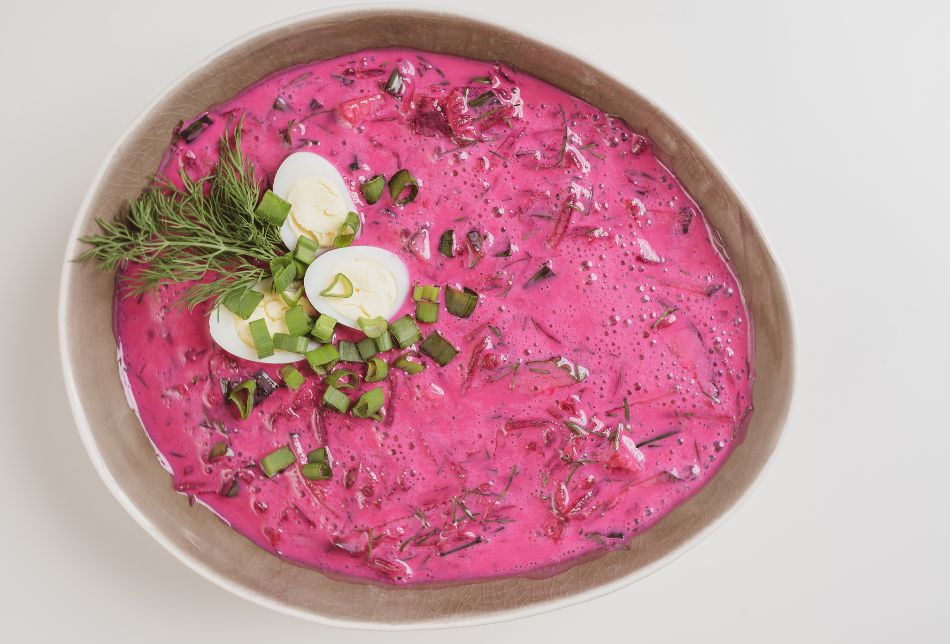
Buttermilk soup has between 380 and 420 calories per liter and contains beets which create the vibrant pink color.
The pink buttermilk soup is a component of weight-loss diets because it contains calcium, magnesium, B vitamins, and water.
It aids in the body’s detoxification processes and the elimination of edema.
3. Cripps Pink Apple
The next pink food on our list is the Cripps Pink Apple.
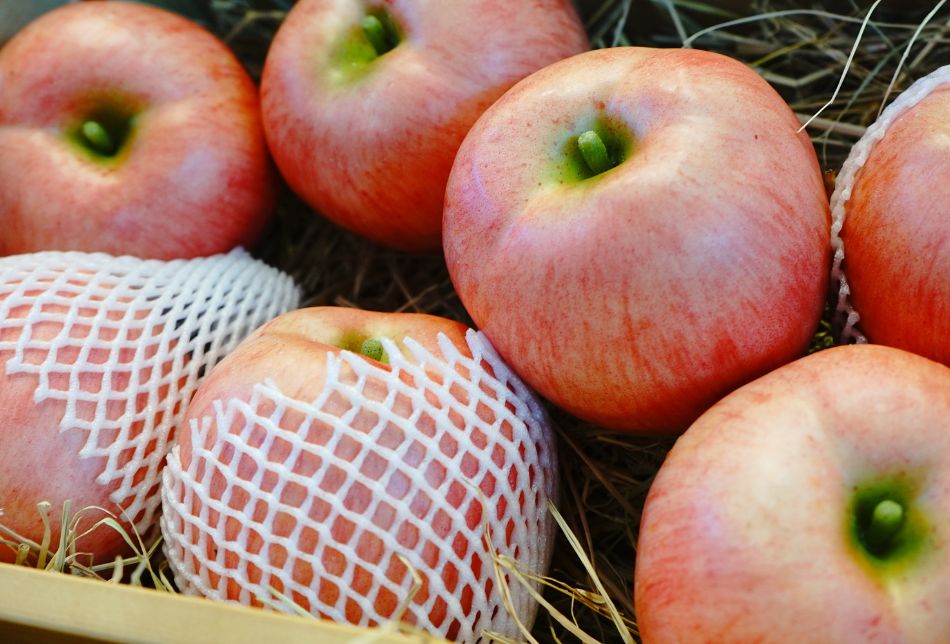
Cripps pink apples are a cross between ‘Lady in Red’ and ‘Golden Delicious.’ They were developed in Australia by Dr. John Cripps in 1973 at the Department of Agriculture’s Stoneville Research Station.
The skin of a Cripps pink apple is a deep pink with occasional white streaks. The apple’s flesh is white or pale pink and is crisp, juicy, and sweet.
These apples are a good source of fiber and vitamins A and C. They can be consumed as it is or used in pies, pastries, jams, and other cooked dishes.
4. Dragon Fruit
The next food that is pink in color is the Dragon Fruit.
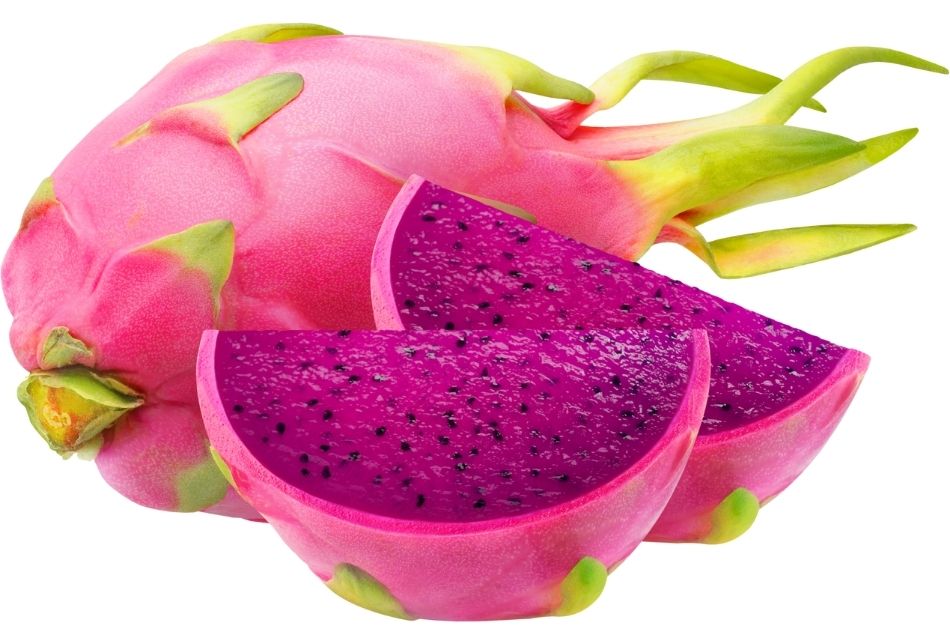
Also known as pitaya or strawberry pear, it is a tropical fruit native to Central America and Southern Mexico.
It has bright pink or red skin with green scales. The flesh is white or pink and contains tiny black seeds.
Dragon fruits are an exceptional source of vitamins C and B1. They can be eaten fresh or used in smoothies, juices, and yogurt.
5. Guava (Sweet White Indonesian Guava)
Another pink fruit on our list is Guava.
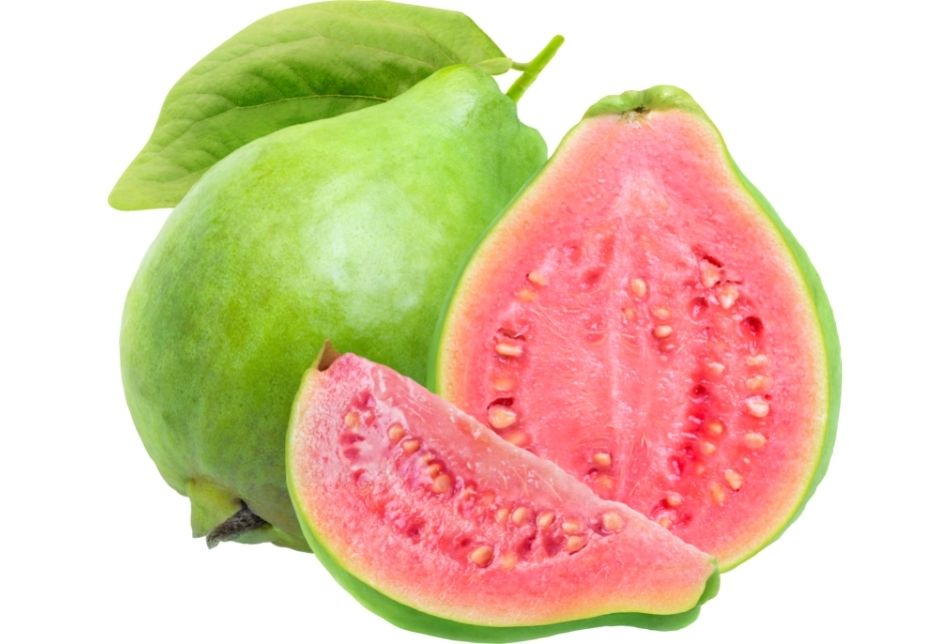
It is a tropical fruit that is native to Indonesia. Guava is round, large, and has green or yellow skin with pink flesh. It tastes sweet and is slightly acidic.
It is a good source of vitamins C and A, fiber, and potassium and can be eaten fresh, used in juices and smoothies, or cooked in pies and other desserts.
Guava contains 4 times as much vitamin C as an orange and 3 times more protein and fiber with 2X the amount of lycopene than tomato has.
6. Pink Grapefruit
The next food on our list is pink grapefruit.
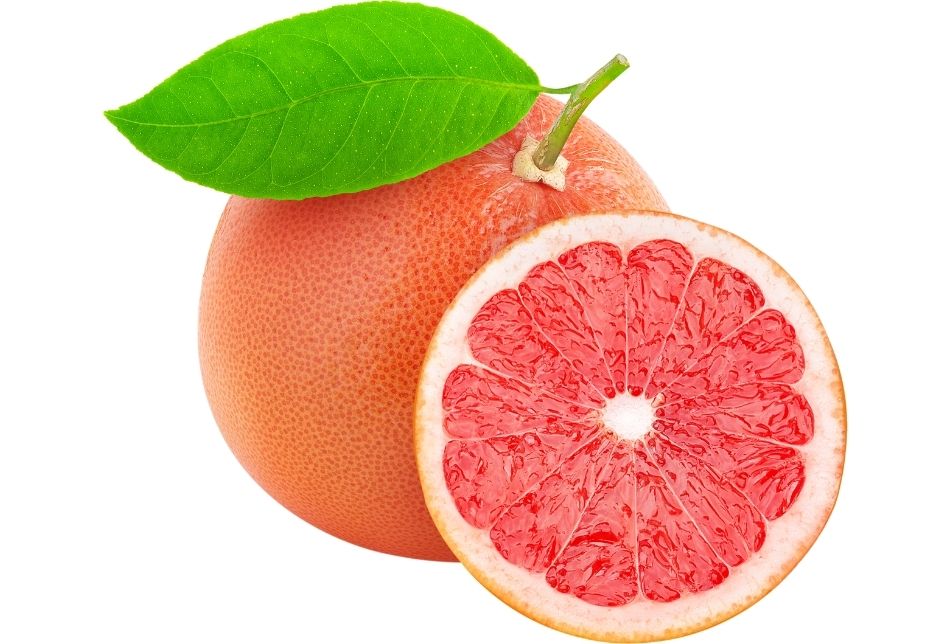
A citrus fruit native to Southeast Asia, it is round or oval and has pink or red skin and flesh. The flavor is tart and acidic.
Pink grapefruit is a good source of vitamins A and C, fiber, and potassium. It can be eaten fresh, used in juices and cocktails, or cooked in pies and other desserts.
Fact: One cup of pink grapefruit has as much lycopene as four ounces worth of tomatoes.
7. Ham
Ham is a type of pork that has been cured, smoked or both.

It is pink in color and can be eaten fresh or cooked.
Ham is a good source of protein and vitamins B1 and B12. It can be eaten alone or in sandwiches, salads, and other dishes.
Ham is the oldest meat of man, with roots that go back to prehistory.
It is said that French people invented curing and smoking pork for Ham.
8. Hidden Rose Apple
The Hidden Rose Apple is a variety of apples developed in Australia. The apple is a rare and natural hybrid first discovered growing in the wild around 1960.
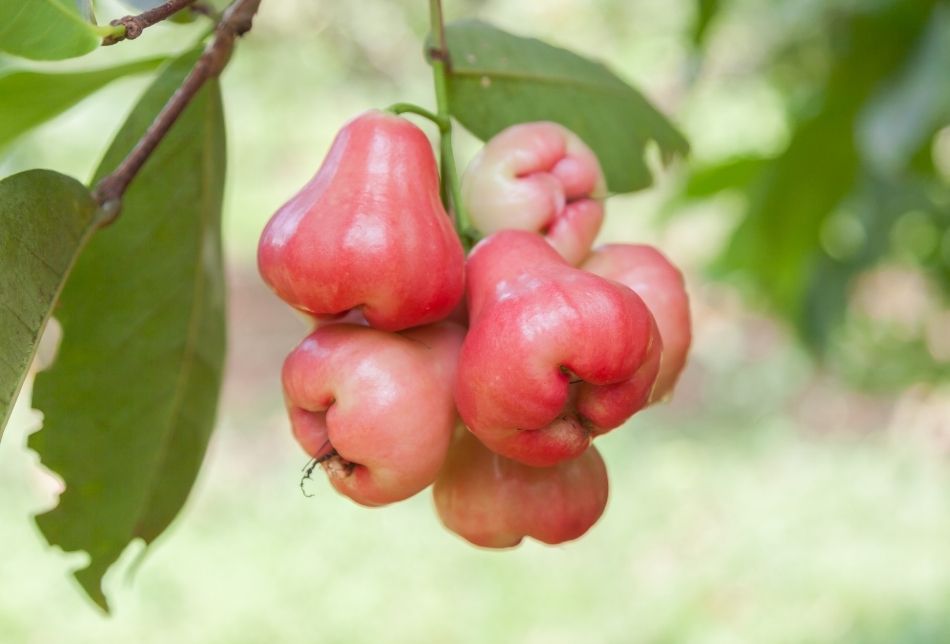
The skin of the Hidden Rose apple is a pale yellow with white freckles and white or pale pink flesh. The flavor is sweet and tart with hints of strawberry.
The photo is of a regular rose apple which can either be pink or red in skin color.
Hidden Rose apples are a good source of fiber and vitamins A and C. They can be eaten fresh, used in pies or baked goods, or made into cider.
9. Highland Burgundy Red Potato
Highland Burgundy Red potatoes were developed in Scotland first. They are named after the Duke of Burgundy, who was served this in London to add some color to the dish.
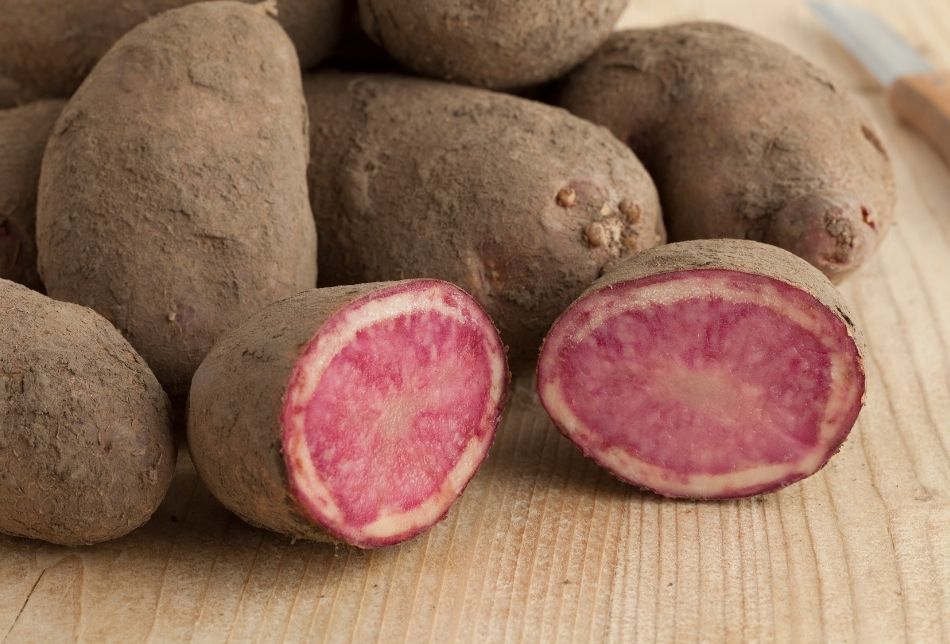
They are part of the ‘Solanum tuberosum’ species, including the common potato.
Highland Burgundy Red potatoes have bright burgundy skin and red flesh.
They are a waxy type of potato good for chipping, roasting, and making into salads.
Highland Burgundy red potatoes are a good source of fiber, vitamins C and B6, and potassium.
10. Himalayan Salt
Himalayan salt is a type of rock salt found in the Himalayas’ foothills in the Punjab region of Pakistan.
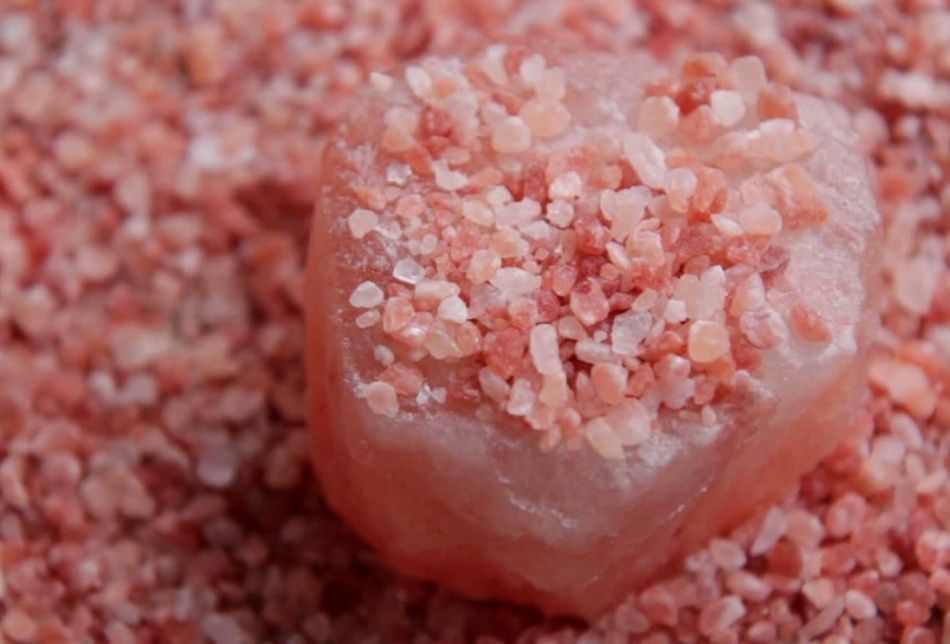
Due to its high mineral content, it is pink, beet-red, or reddish.
It is an impeccable source of minerals such as calcium, potassium, magnesium, and iron. You can use it for cooking, baking, or as a finishing salt.
In addition, pink salt offers several health benefits, such as improved respiratory function and reduced blood pressure.
11. Lilly Pilly Berries
Lilly pilly berries come from Southeast Asia and Australia.
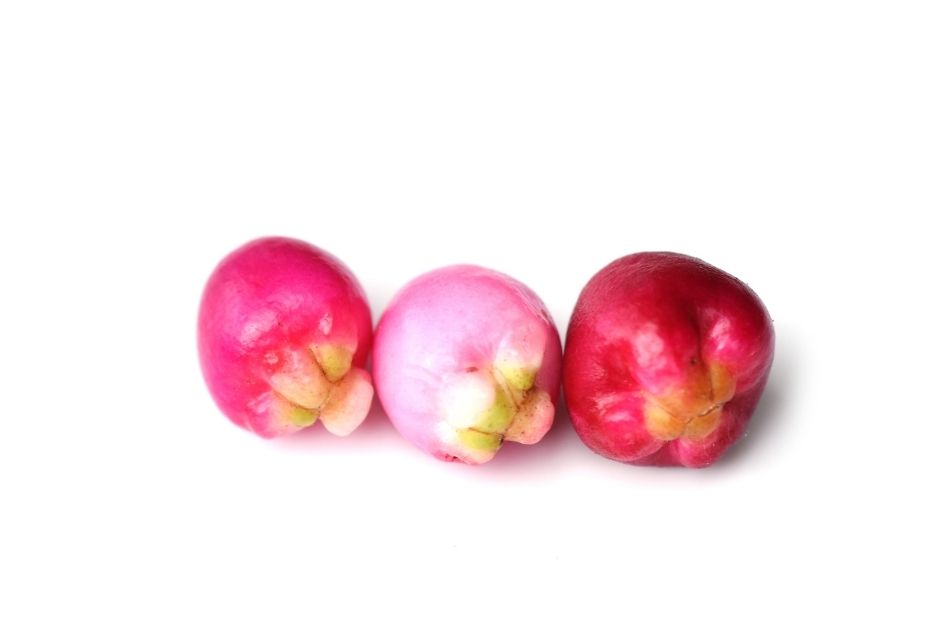
They have a metallic and sweet-tart flavor with fruity notes of pears, cloves, apples, and cranberries, making them perfect for preparing jams, jellies, and pies.
The berries are pinkish-red to magenta with white flesh. They are round or oval and grow in clusters.
You can eat them fresh or cook them to make sauces, jams, and cordials.
Lilly pilly berries are packed with Vitamin C and antioxidants.
12. Lychee
Lychee is a small, pinkish-red fruit that grows on an evergreen tree and is originally from China.
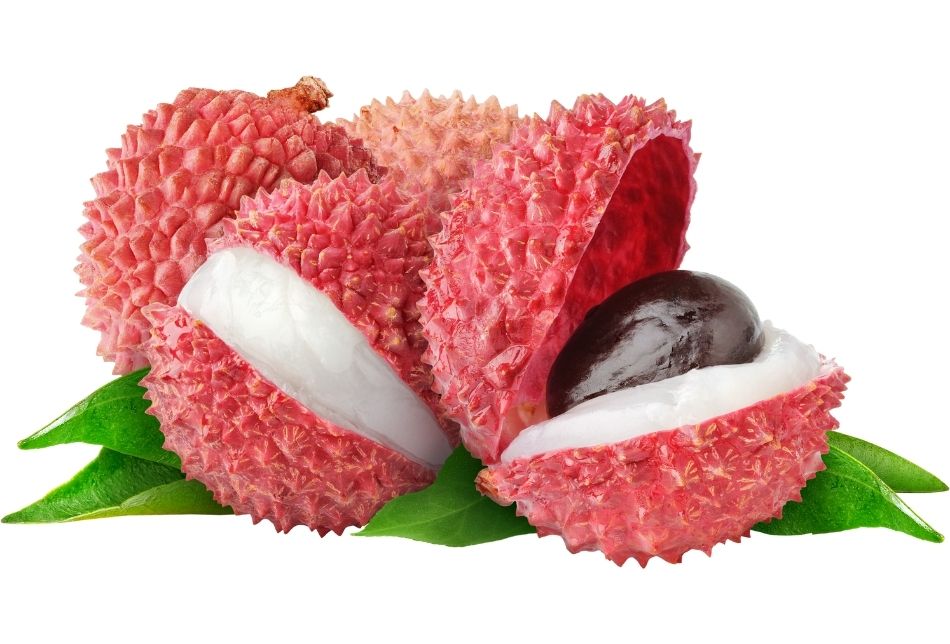
The tree can also be found in other parts of Asia, such as India, Nepal, Bangladesh, and Sri Lanka.
The skin of lychee is rough (inedible), pink or red, with a light fragrance.
The flesh is like jelly, pink in color, and has a sweet taste. You can eat them fresh or prepare delectable desserts.
The juicy fruit contains vitamin C, rutin, epicatechin, potassium, and copper. They can help you prevent heart disease, cancer, and diabetes.
13. Marshmallow
Marshmallows are made of sugar, water, and gelatin that have been beaten to a solid but soft consistency.
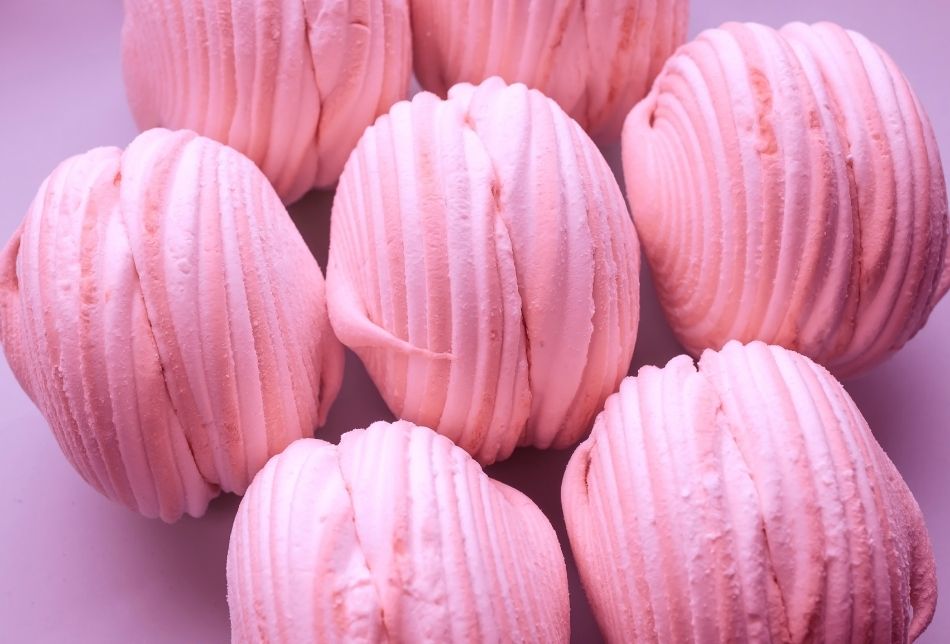
It is typically formed into shapes and dusted with cornstarch before being used as a filling in baked goods.
The first people to eat a sticky confection were the ancient Egyptians.
The epidermis of the digestive tract can occasionally be protected by a coating made of marshmallows. It has compounds that may lessen coughing and fight infections.
14. No-Bake Strawberry Cheesecake
No-bake strawberry cheesecake first originated in Greece. It is a combination of fresh strawberries, creamy cheesecake, and crispy graham cracker crust.
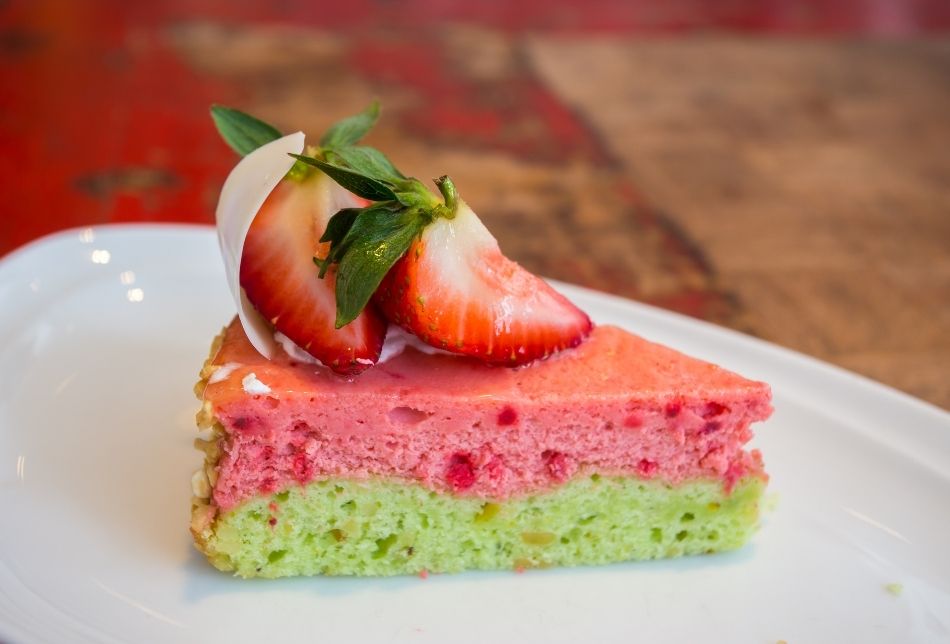
In one slice of no-bake strawberry cheesecake, there are about 374 calories. Flavonoids, which are potent antioxidants that support the body’s defenses against disease and aging, are abundant in cheesecake.
It has a lot of magnesium, copper, and other heart-healthy elements that help regulate blood pressure and heart rate.
Strawberry cheesecake is a low-sugar, gluten-free dessert and is safe to consume even on a keto diet.
15. Octopus
The octopus is a sea creature with eight arms and is related to squid and cuttlefish.

They can be blue, brown, green, gray, and pink and have soft bodies with no internal skeleton.
Octopuses are inhabitants of all the world’s major oceans but are more abundantly found in warm tropical waters. They can change their skin color for camouflage and communication.
You can cook them or eat them raw for their exceptional protein, vitamins, and minerals source.
Interesting fact: The octopus’s arm is a living, breathing entity that can think for itself.
16. Ornamental Cabbage and Kale
Ornamental cabbage and kale are brassica plants grown for their colorful and crinkled leaves. The leaves are typically purple, red, or pink, with white or yellow veining.
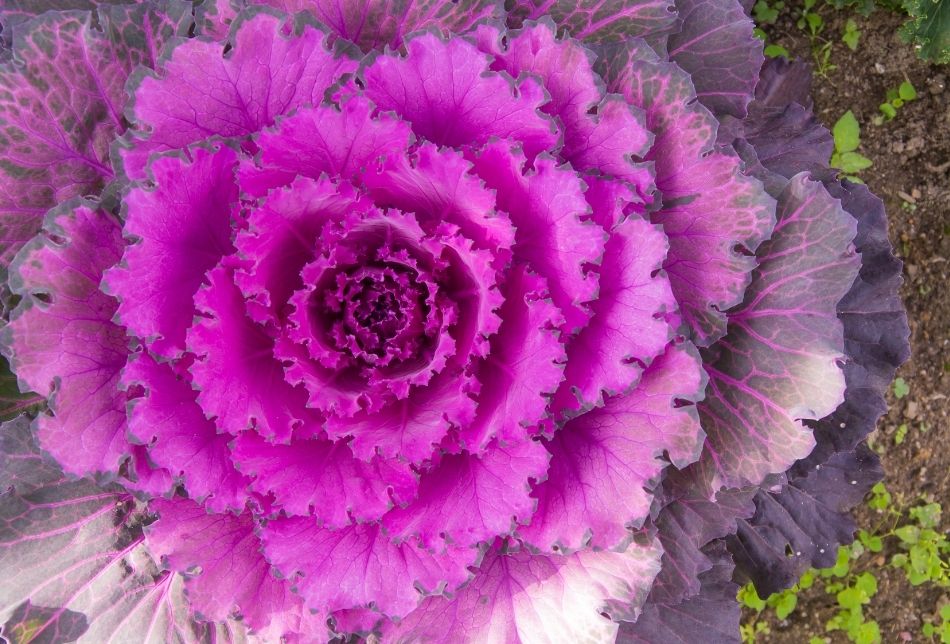
Even though ornamental cabbage and kale are edible, they can be quite bitter. Yet, you can add these to salads or use them as garnish.
Ornamental cabbage and kale are from the temperate parts of Japan, China, and Western and Southern Europe.
The plants are ornamental annuals that are typically used as fall decorations.
17. Pink Banana Squash
Pink banana squash originated in ancient sites in Peru.
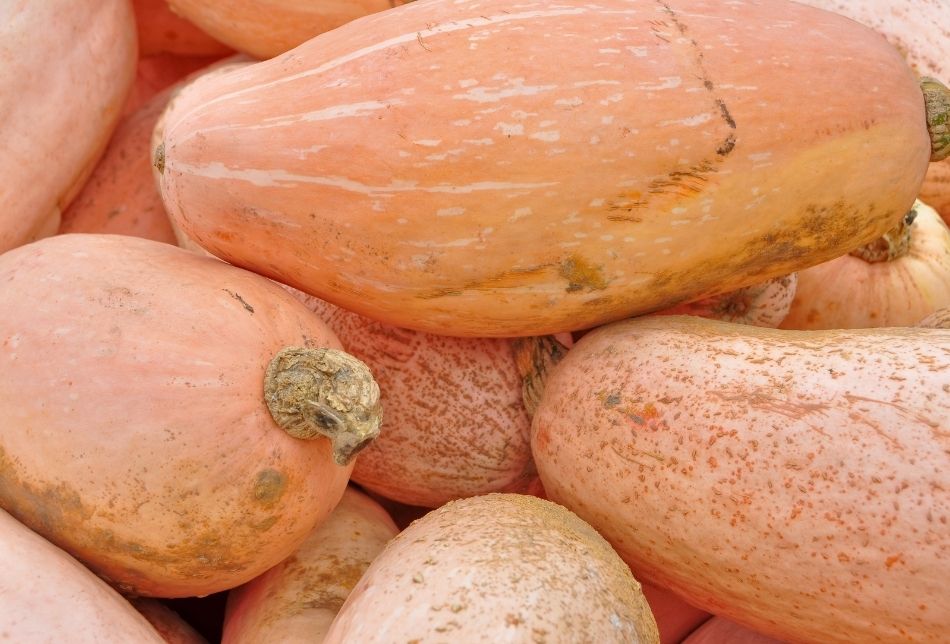
It is a type of winter squash with a sweet and nutty flavor.
Pink banana squash gets its name from its oblong shape and pale-to-yellow skin color, making it look like a small banana.
This variety of squash is rich in antioxidants and vitamins A, B, and C. It can be eaten steamed, sauteed, or roasted. Pink banana squash can also be used to make soups, pies, and other sweet or savory dishes.
18. Pink Caviar
Pink caviar is obtained from the Oncorhynchus gorbuscha species.
This fish is indigenous to the chilly coastal waters of the arctic and north pacific oceans.
Pink salmon is a cost-effective and environmentally friendly commodity. It is high in omega-3 fatty acids and has established itself as a champion of excellent mental and physical health.
Roe enhances your entire immune system while also promoting brain and eye development.
Interesting Fact: Lots of pregnant ladies eat pink caviar because of its health benefits.
19. Pink Cheese
The pink cheese was created with Asian palates in mind. It was created for a Hong Kong client by a Swiss family business. After experimenting with beets and strawberries, they discovered a natural colorant.
The pink cheese has a flexible and crumbly texture with a milky freshness and is encircled by a hot pink rind.
Relief from hypertension and osteoporosis are two of cheese’s main health advantages. It also aids in weight gain, bone health maintenance, and dental care.
20. Pink Donuts
A pink donut is pink-frosted with rainbow sprinkles and uses the chain’s classic glazed donut as its foundation.
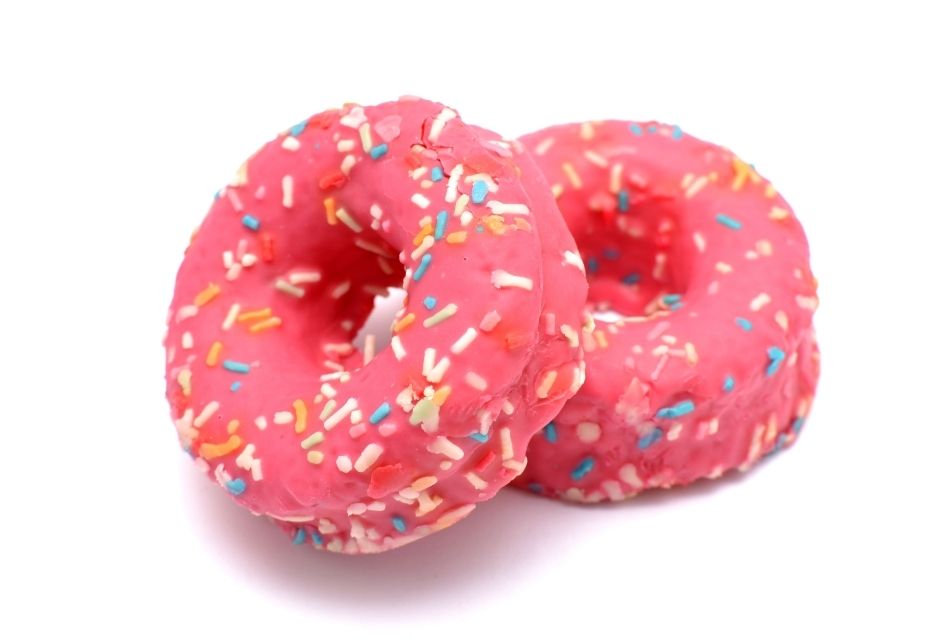
After that, it is “hand-dipped” in white chocolate truffle frosting with strawberry flavor and embellished with jimmies in various colors.
There are about 260 calories in one pink doughnut.
Pink donuts’ sugar content aids in memory and focus.
Donuts with cheese, which provide calcium, and cinnamon, which helps with blood pressure control and sleep, may have health benefits.
21. Pickled Eggs
Pickled eggs are hard-boiled eggs that have been preserved in vinegar or brine.
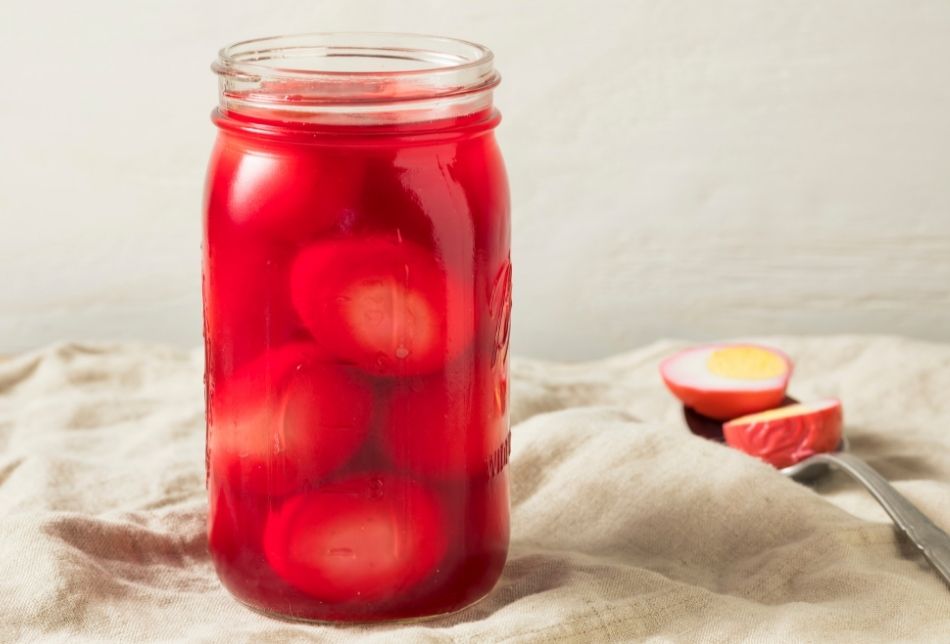
This was initially intended to preserve the meal so that it could be consumed months later.
Two big pickled eggs have 145 calories each. If you eat more than one pickled egg, it can be a rich source of protein.
They were a favorite dish among German immigrants, especially the Hessian mercenaries fighting against colonists during the Revolutionary War.
22. Pink Oyster Mushroom
They are a type of gilled mushroom that get their name from their oyster-shaped cap.
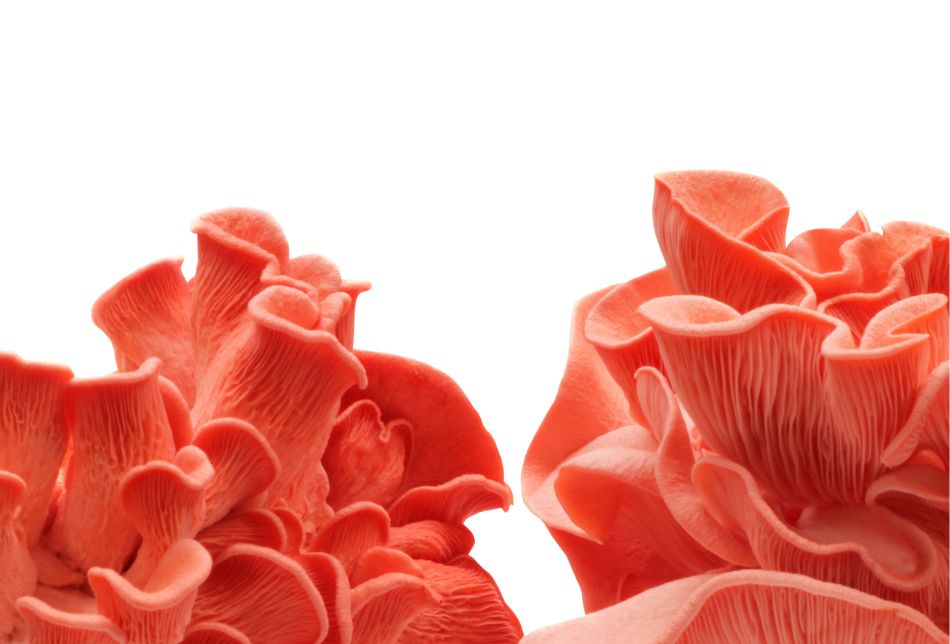
These mushrooms have a mild seafood flavor with a chewy texture.
Pink oyster mushrooms can be eaten raw or cooked to make soups and stews or are used in stir-fries. They are a good source of vitamins B and C and potassium, selenium, copper, and iron.
First cultivated in Germany, pink oyster mushrooms are now found in subtropical and temperate parts of the world.
23. Pink Pearl Apples
The next pink food on our list is Pink Pearl Apples.

Pink Pearl apples are an apple variant characterized by their pink flesh.
The fruit is small to medium in size and has a slightly tart or sweet-tart flavor.
These apples are a good source of fiber, vitamin C, and antioxidants. You can eat them fresh or prepare pies, tarts, scones, and other dishes.
24. Pink Peppercorns
Pink peppercorns are the berries of a South American tree called the Peruvian pepper tree (Schinus molle) of pink or red color.
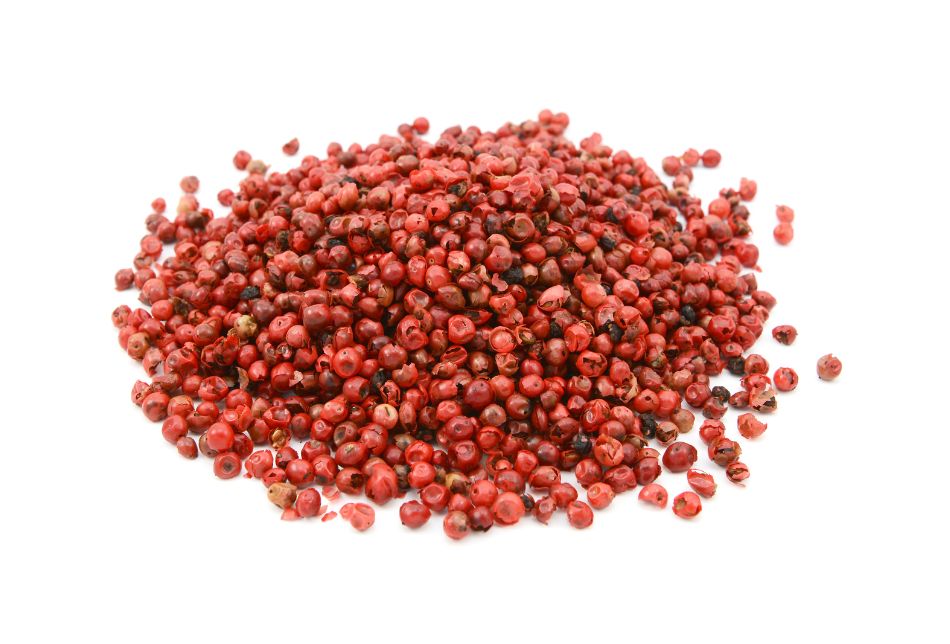
They have a sweet, fruity flavor with a hint of spice (similar to black peppercorns).
You can use them whole or as a decorative element on top of dishes.
They are a powerhouse of antioxidants and can also be used in sauces, marinades, vinaigrettes, and salad dressings.
These cousins of cashews (and not peppercorns) are native to Brazil and Peru.
25. Pink Radicchio (La Rosa del Veneto Radicchio)
Radicchio is a leafy vegetable (chicory) that belongs to the chicory genus of plants.
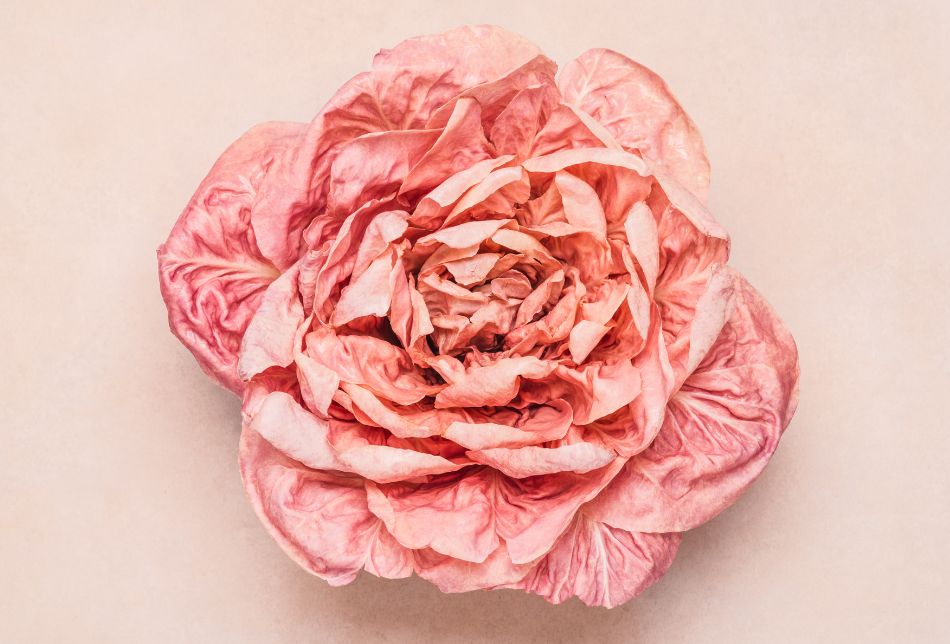
It is native to Northern Italy and has been cultivated there for centuries.
The head comprises many layers connected to one another with thin, soft, and crispy pink leaves.
Pink radicchio is less bitter than its red counterpart and has a slightly sweet flavor. You can eat it in the form of salads or cook various dishes.
Pink radicchio is a good source of vitamins A and C, fiber, and antioxidants.
Fact: The Sagra di Radicchio is an annual event in Seattle, WA, that celebrates pink radicchio’s deliciousness.
26. Pink Root Onions
Pink root onions are a type of onion that gets its pink color from anthocyanins.
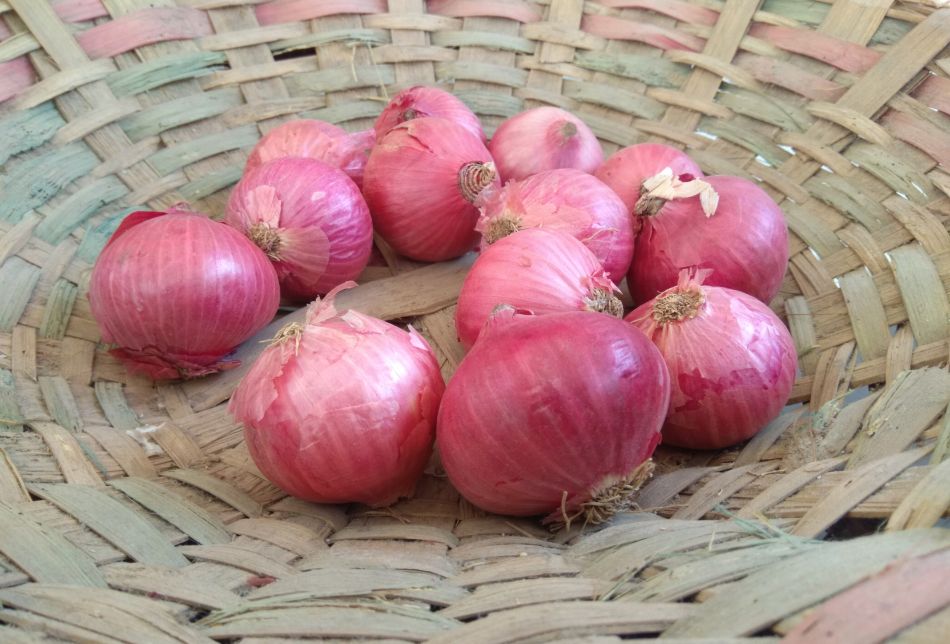
They are native to Central and South America and were introduced to Europe in the 16th century, and have grown there ever since.
Pink root onions are a good source of vitamins A, C, and B6. They can be cooked or used as ornamental plants due to their colorful flesh.
27. Pinkglow Pineapple
Pinkglow pineapple is a genetically modified variant of pineapple. It was created through genetic engineering by Del Monte.
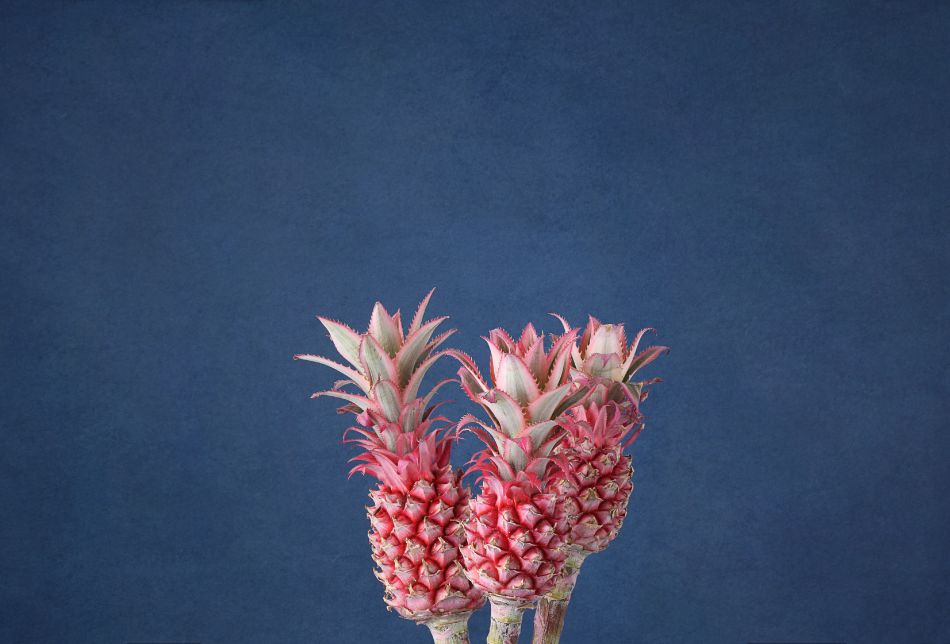
The main difference between pinkglow pineapple and regular pineapple is its appearance; pink glow pineapple has pink flesh due to lycopene.
This pineapple is very sweet, juicy, and less sour than its yellow counterparts.
They have a higher vitamin C content than traditional pineapples and contain lycopene. You can consume them fresh or in desserts, smoothies, and other dishes.
Fact: The Pinkglow Pineapple is a registered trademark of the company Del Monte. They are grown in the South-Central region of Costa Rica.
28. Pink Macarons
Pink macaroons are a type of French cookie that is made from almond paste, egg whites, and sugar. They are flavored with rose water or vanilla extract and typically dyed pink.
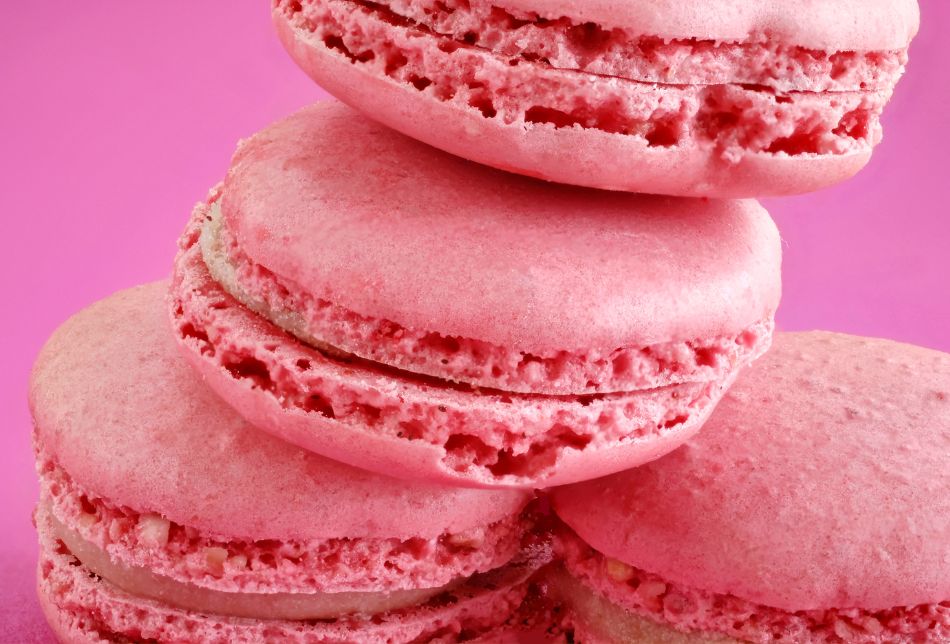
One pink macaron has a calorie content of between 70 and 100 calories. The macaroons are traditionally served at weddings, baby showers, and other special occasions.
Macaroons promote tissue and muscle mending and repair.
Therefore they can aid in the recovery of sore muscles following a strenuous workout and assist the body in withstanding strenuous exercise.
29. Pink M&Ms
Small chocolate candies called M&Ms have a form resembling a button. The milk chocolate M&Ms in this flavor have a hard candy shell that is pink in color.
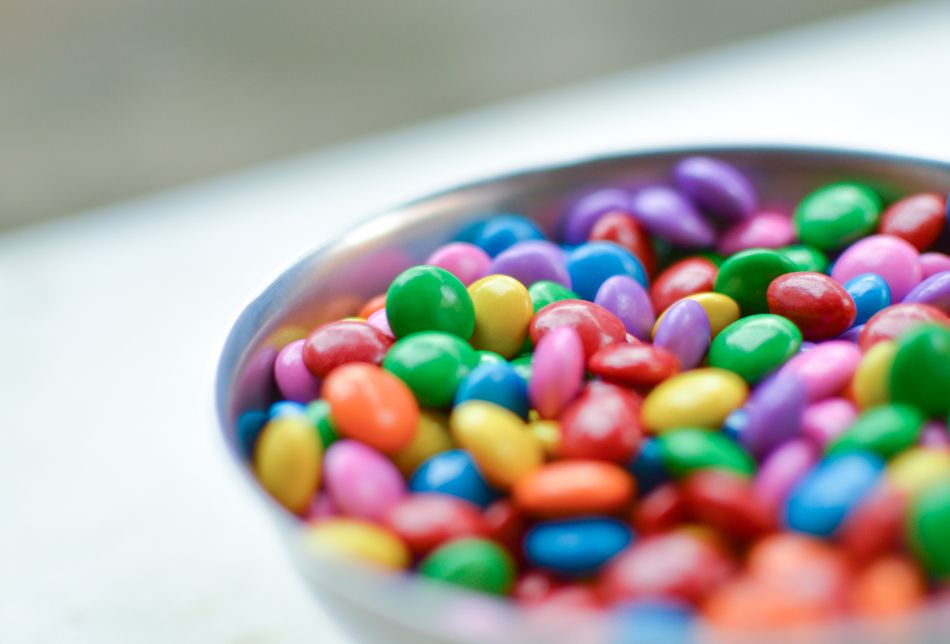
They first originated in the United States of America. There are three calories or so in one M&M.
They are rich in flavonoids, which are recognized for their antioxidant properties, and antioxidants that aid the body’s cells in resisting harm from free radicals.
30. Pink Muscatel Grapes
Pink Muscatel grapes have a light rose pink color and are incredibly sweet and delicate.
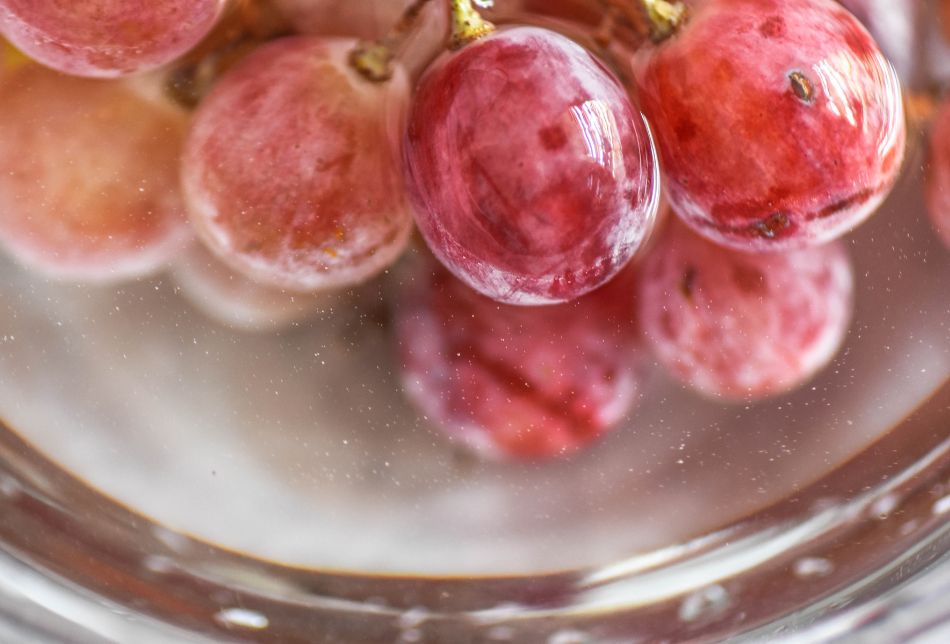
The Pink Muscatel is a subvariety of the Muscatel grape, which dates back to early Greek and Roman vineyards.
This grape goes well with a glass of dry white wine and a fruit and cheese platter.
They are rich in antioxidants like beta-carotene and resveratrol. The grapes also contain vitamin C and manganese.
31. Pink Pomegranate
Pink pomegranates are from the Himalayas in northern India and Iran. They grow on small trees or bushes.
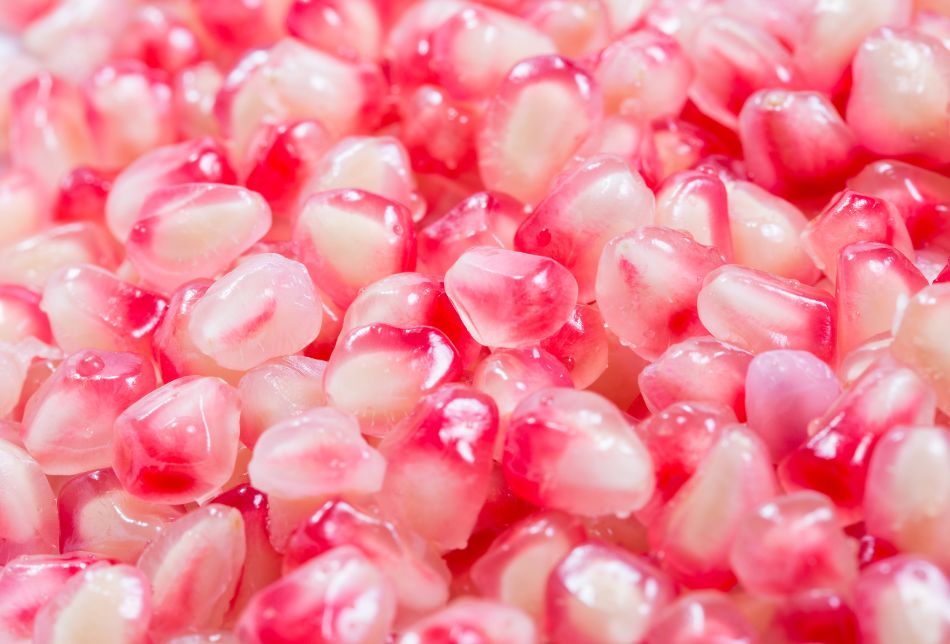
The skin of a pomegranate is deep-pink, thin, and leathery, and the inside is filled with edible seeds. The fruits enclose juicy flesh full of sweet, tangy flavor.
Pink pomegranates are a good source of fiber, vitamins C and K, potassium, and folate.
They can be eaten fresh or used in juices, jams, jellies, and other cooked dishes.
32. Raspberries
Raspberries are an aggregate fruit that belongs to the rose family.
They grow on perennial plants with biennial canes and are white, pink, red, purple, or black depending on the species and when they’re picked.

Raspberries are an excellent source of vitamins C and K and manganese. They are also an excellent source of dietary fiber and copper.
One cup of raspberries has about 64 calories and 8 grams of fiber.
Raspberries are believed to have originated in Turkey and have spread worldwide.
33. Rhubarb
Rhubarb is a perennial plant that produces edible stalks. The stalks are ruby red, speckled pink, or light green and have a tart flavor (and sometimes bitter).

They can be used in pies, jams, muffins, bread, crisps, and other desserts.
Rhubarb is a good source of fiber and vitamins A and C. These should be cooked before eating, as the raw stalks are known for causing indigestion.
Rhubarb is originally from India.
34. Rose Petals
Roses have been associated with love, appreciation, and admiration for centuries. The color pink has also been linked to these emotions.
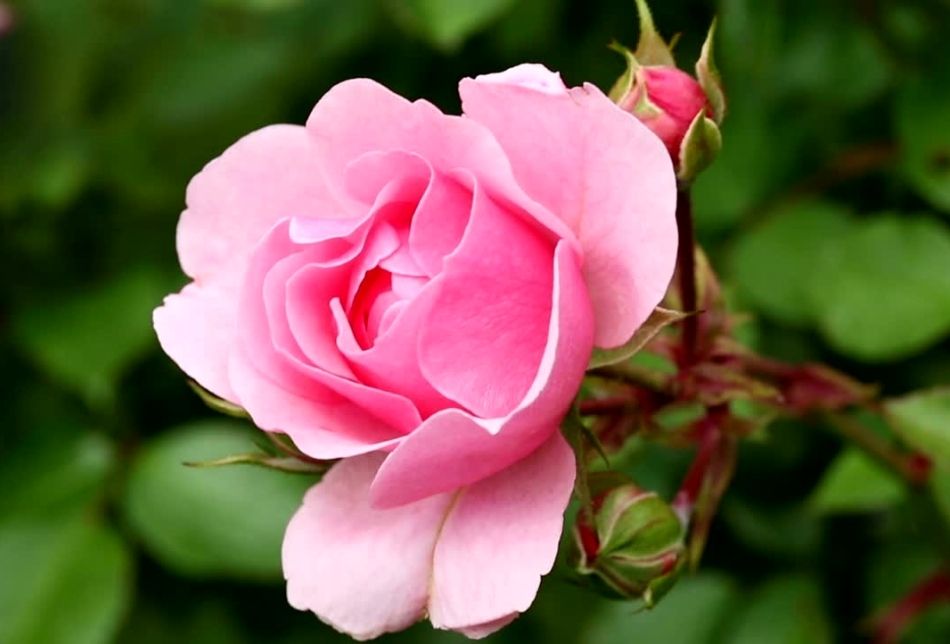
Pink roses are the perfect way to show your affection for someone special.
The pink rose petals can be used to add flavor and color to several dishes, from salads to desserts. They can also be used as a natural food dye.
Pink rose petals are a source of vitamin C and antioxidants. When used in cooking, they should be removed before eating as they can cause indigestion.
You can also prepare rose tea using the petals; the tea is packed with antioxidants.
35. Rosé Wine
Rosé wine is made from red grapes but with a minimal contact time between the juice and the skins, giving it its characteristic pink color.
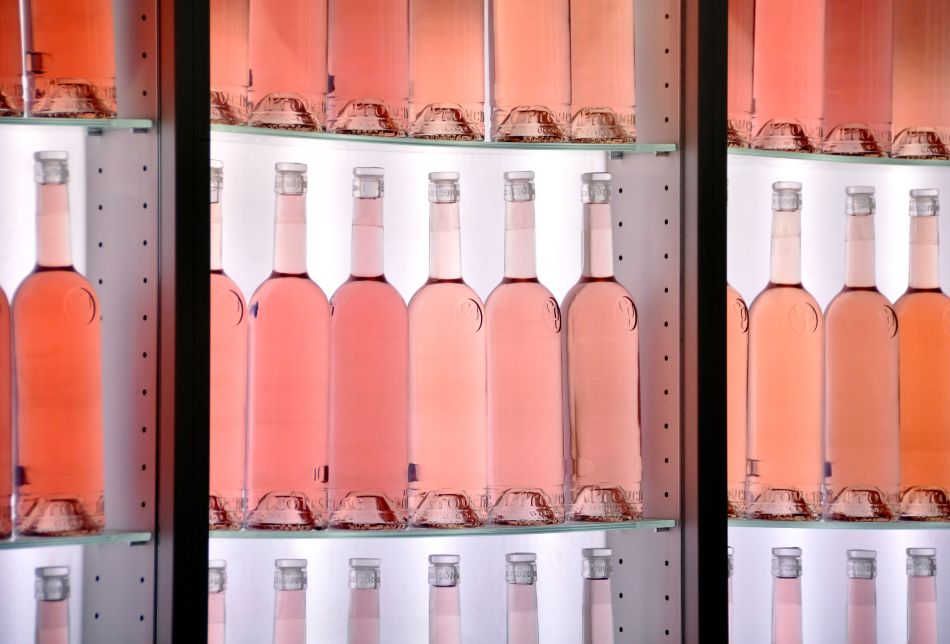
The wine can be dry or sweet and is usually lighter-bodied than red wines. It is often made in a style that is meant to be consumed young and fresh.
Rosé wine is a good source of polyphenols, which are antioxidants that have been linked to several health benefits.
Some include reducing inflammation, lowering cholesterol levels, and protecting against heart disease.
Rose wine has its roots in ancient Greece.
36. Shrimp
Shrimp is a type of shellfish popular in many cuisines around the world. It has a pinkish color and is often cooked before eating.
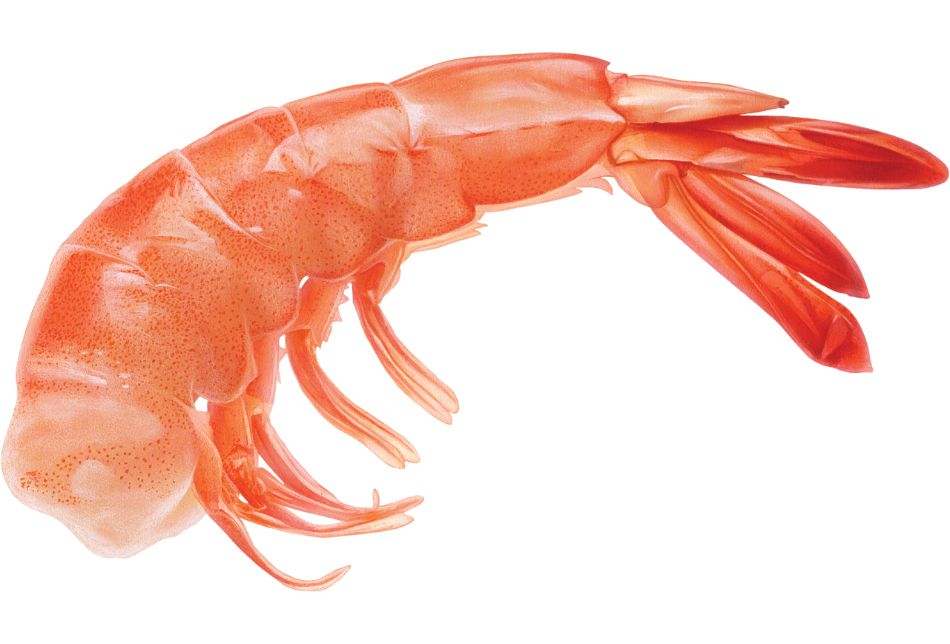
Shrimp is low in calories and fat but high in protein. It is also good omega-3 fatty acids, which have many health benefits.
You can eat it fresh, frozen, canned, or cooked. Besides, you can use it in salads, pasta dishes, rice dishes, soups, and stir-fries. Raw shrimp can cause food poisoning.
Fact: Farmed shrimp comes from India, Vietnam, and Thailand.
37. Swiss Chard (Pink Flamingo)
The Swiss chard is a green and leafy vegetable part of the beet family. It is also known as silverbeet, mangold, or perpetual spinach.
Not to be confused with rhubarb, swiss chard is a different vegetable.
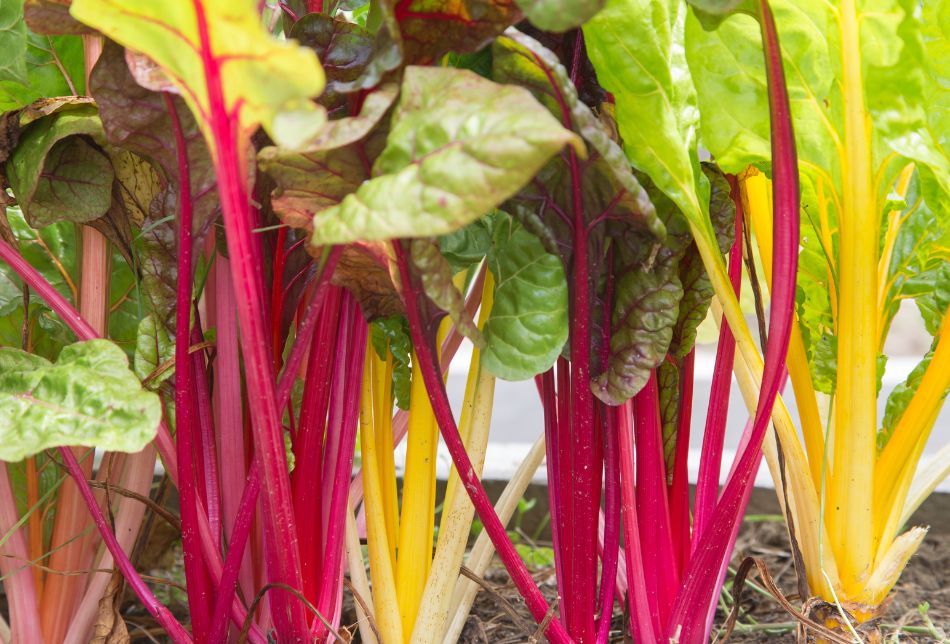
Swiss chard has a slightly bitter taste and is often used in Mediterranean cuisine, where it was first discovered.
The leaves of Swiss chard are dark green with red veins. The stalks are thick, fleshy, and flamingo pink in color. Swiss chard is a good source of vitamins A, C, and K, as well as iron and magnesium.
It can be eaten cooked or raw. It is often used in soups, stews, casseroles, and salads. The leaves can be steamed, sautéed, or stir-fried.
38. Tuna
Tuna is a saltwater fish in the Pacific, Atlantic, and Indian Oceans. It is an important food source for many people around the world.
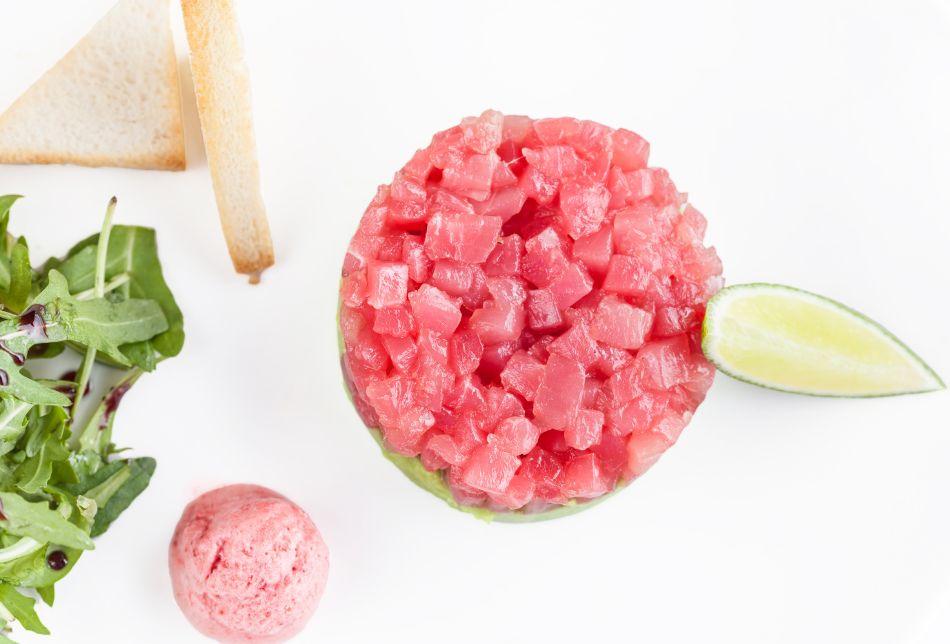
Tuna is pink when raw but turns white or light brown when cooked. It is a popular ingredient in sushi and sashimi. It is also used in canned foods, such as tuna fish sandwiches and tuna salads.
The nutrients in tuna include protein, mercury, and omega-3 fatty acids, which can help improve heart health.
Tuna fish is native to the eastern and western Atlantic oceans and the Mediterranean Sea.
39. Turkish Delight
Turkish delight, also known as lokum, is a type of confectionery made from starch, sugar, and gelatine. It is often flavored with rosewater, lemon, or bergamot orange.
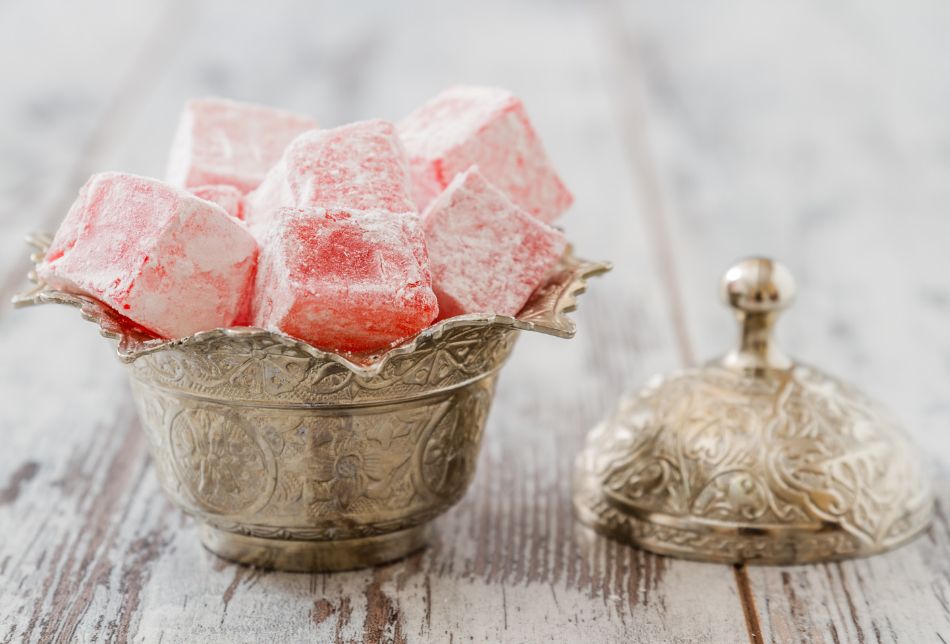
Turkish delight is a famous sweet in many parts of the world and has been around for centuries.
It is thought to have originated in Turkey during the Ottoman Empire.
It is usually served as a small treat or after-dinner dessert. You can eat it on its own or with tea or coffee.
40. Strawberry Ice Cream
Pink or pale red is the most common hue for strawberry ice cream.
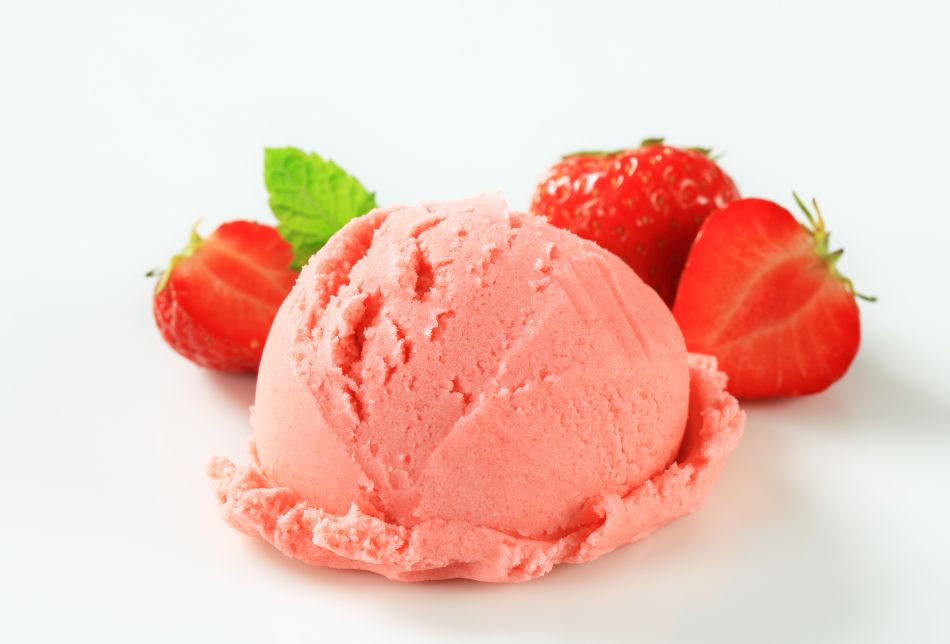
It is prepared with strawberries or strawberry flavoring. The most common ingredients are eggs, cream, vanilla, and sugar combined with fresh strawberries or strawberry flavors.
Half a cup of strawberry ice cream has 140 calories, 17g of total carbs, 17g of net carbs, 6g of fat, and 3g of protein.
Your immune system will benefit from the nutrients it contains.
41. Watermelon Radish
The last food on our list of pink foods is watermelon radish. It is from China.
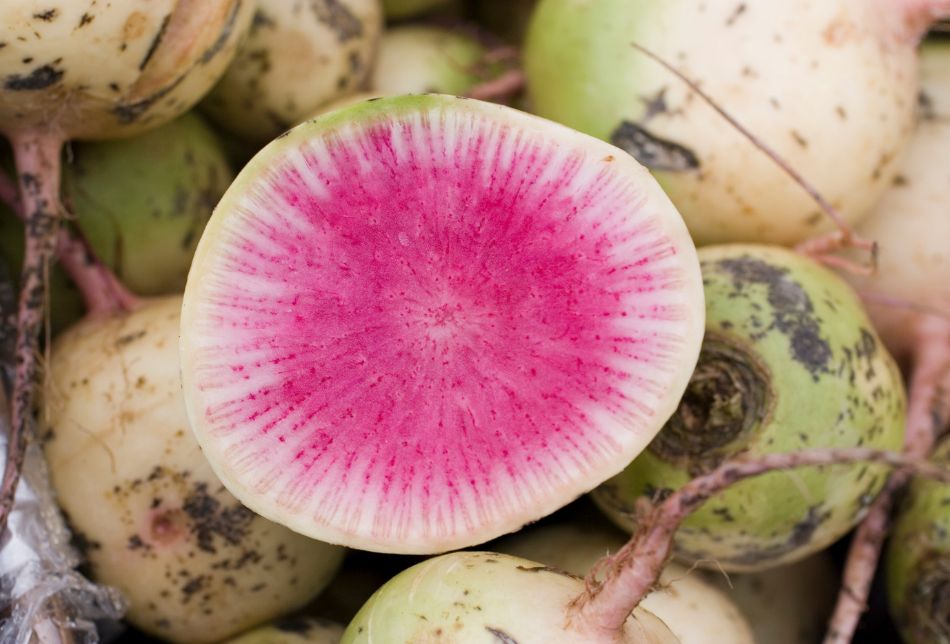
Watermelon radish is a type of winter radish with a distinctive white exterior and pale green shoulders with a bright pink interior.
This radish variant is a good source of vitamins A, C, and B6, besides minerals such as magnesium, potassium, and calcium. You can have it as it is or use it as a garnish or salad ingredient.
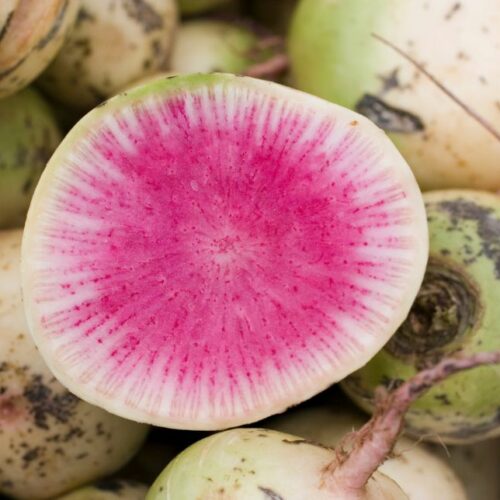
Foods That Are Pink In Color
Ingredients
- Beets (or Beetroot)
- Buttermilk Soup
- Cripps Pink Apple
- Dragon Fruit
- Guava (Sweet White Indonesian Guava)
- Pink Grapefruit
- Ham
- Hidden Rose Apple
- Highland Burgundy Red Potato
- Himalayan Salt
- Lilly Pilly Berries
- Lychee
- Marshmallow
- No-Bake Strawberry Cheesecake
- Octopus
- Ornamental Cabbage and Kale
- Pink Banana Squash
- Pink Caviar
- Pink Cheese
- Pink Donuts
- Pickled Eggs
- Pink Oyster Mushroom
- Pink Pearl Apples
- Pink Peppercorns
- Pink Radicchio (La Rosa del Veneto Radicchio)
- Pink Root Onions
- Pinkglow Pineapple
- Pink Macarons
- Pink M&Ms
- Pink Muscatel Grapes
- Pink Pomegranate
- Raspberries
- Rhubarb
- Rose Petals
- Rosé Wine
- Shrimp
- Swiss Chard (Pink Flamingo)
- Tuna
- Turkish Delight
- Strawberry Ice Cream
- Watermelon Radish

